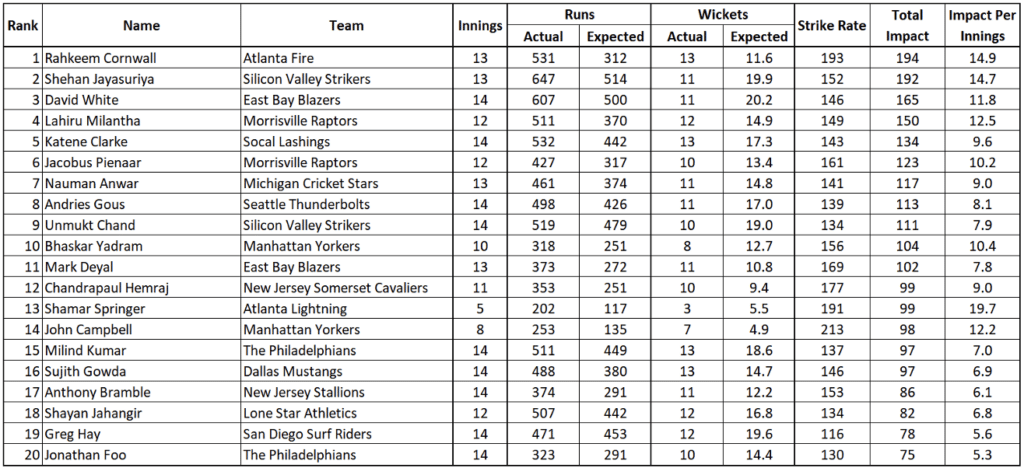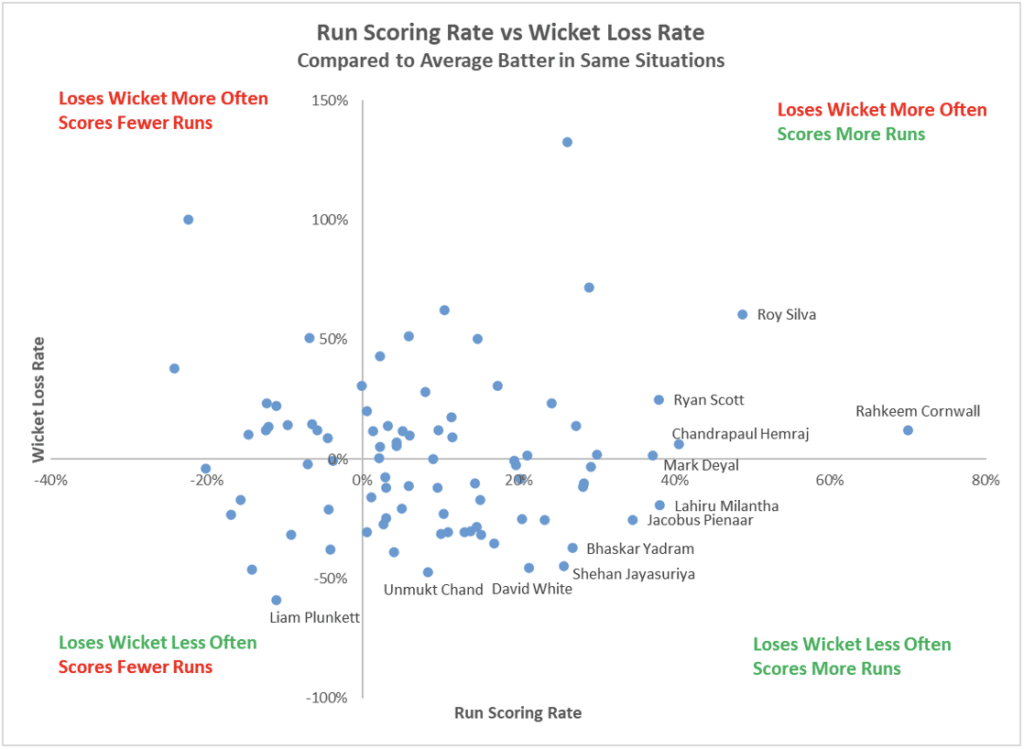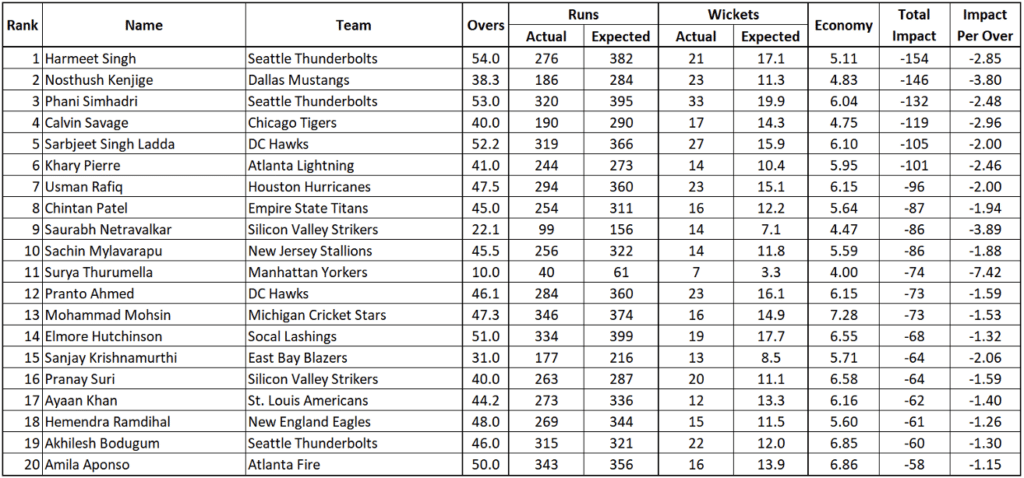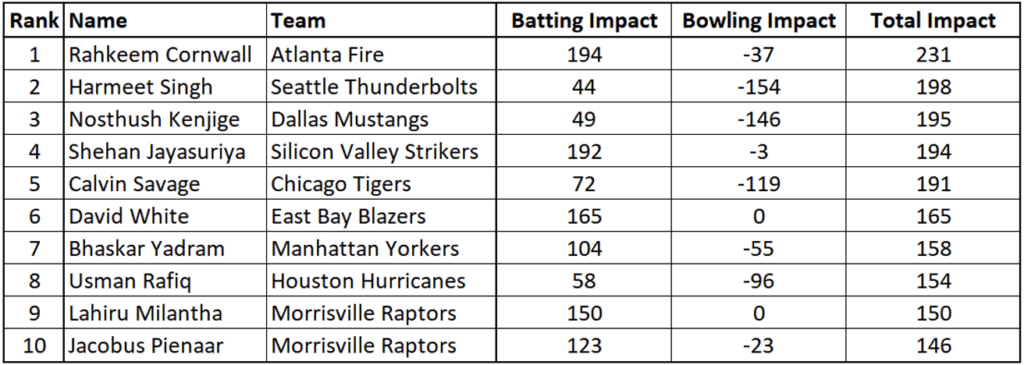With the regular season coming to an end this past weekend, it’s a great chance to take a moment to appreciate the top performers of the MiLC season before we turn our attention to the playoffs. In this post, Tom Nielsen covers the top performers of the 2022 Minor League Cricket season, using our Total Impact stats. We’ll look at the top individual Batters, Bowlers, and All-Rounders of the season. For a refresher on the impact stats, check out this post from earlier in the season.
Top Batters
First up, we’ll look at the top 20 batters of Minor League Cricket on a Total Impact basis. The table shows the actual runs and wickets for each batter, compared to expected runs and wickets for the average batter in the same match situations, in addition to strike rate, total impact, and impact per innings (which adjusts for players missing matches due to rain outs or other commitments). The impact figures account for ground impacts, so players who play at especially batter-or-bowler-friendly grounds will not be unfairly rewarded or punished.

We’ll take a deep dive into the top five and call out some other notes:
- Rahkeem Cornwall, Atlanta Fire: One of the highest-profile signings of the season, Cornwall came through in spades, smashing 531 runs at an astonishing 193 strike rate. For comparison, the highest strike rate from a 500+ run batter in 2021 was just 152. Rahkeem opened the batting for the Fire every match and usually didn’t take any time getting started, reaching 20 runs by his tenth ball faced on six separate occasions this year. He started and ended the season in classic Rahkeem style, with a 93 (41) on opening weekend and 86 (50) on the final weekend, two of his four 50s on the season.
- Shehan Jayasuriya, Silicon Valley Strikers: Sitting just two runs behind Cornwall on Total Impact from the same number of matches played but with a much different statistical profile is Shehan Jayasuriya. Jayasuriya led Minor League Cricket with 647 runs scored, on a lower (but still excellent!) strike rate of 152. Jayasuriya was Silicon Valley’s #3 batter all year, and had an incredible stretch early in the season including back to back unbeaten centuries on July 4th weekend: 112* (60) and 115* (65), which were followed up by a 63 and 86 the next weekend.
- David White, East Bay Blazers: With Jayasuriya, David White was the only batter in Minor League Cricket to surpass 600 runs, with the next highest at just 532 on the season. David White was extremely reliable all year while opening the batting, scoring at least 35 runs in 10 of his 14 matches, and being out for under 10 just twice: doing an outstanding job building a platform for the Blazers. As part of a league-wide trend towards faster scoring, White bumped his strike rate up to 146 this season from just 115 in 2021, setting the tone in a season-opening 35 (15) flurry in a narrow win against the Seattle Thunderbolts.
- Lahiru Milantha, Morrisville Raptors: Potentially a candidate for most improved player in Minor League Cricket, Lahiru Milantha put up 511 runs at a 149 strike rate, compared to just 157 and 118 in 2021 (from 5 fewer matches). Lahiru topped 40 runs in eight of his 12 matches, the highlight being a season-defining performance against the Atlanta Fire on the penultimate weekend, when he went 91 off 47 to lead Morrisville to 203 runs, which they defended to set up playoff-clinching opportunities in the last weekend.
- Katene Clarke, SoCal Lashings: The New Zealander broke onto the Minor League Cricket scene in a big way in 2022, Clarke put up 532 runs at a strike rate of 143 opening the batting for the SoCal Lashings. Katene Clarke was unafraid of big competition from Northern California this year, putting up 99 (70) against Golden State, 60 (46) against Silicon Valley, and 117* (70) against the East Bay.
Honorable Mentions: A couple batters snuck into the top 20 despite not playing a full schedule. First, Shamar Springer of the Atlanta Lightning, who played in the Lightning’s first five matches, putting up 202 runs highlighted by 71* (31) and 65* (25) in winning efforts. John Campbell bashed 253 runs at over two runs per ball for the Manhattan Yorkers through July, highlighted by 85* (32) against the Somerset Cavaliers on July 9th, the most runs scored at 32 balls in Minor League Cricket this season.
The chart below shows run scoring rates and wicket loss rates for each batter that faced at least 150 balls in Minor League Cricket relative to the average batter in the same match situations. Batters with elite run scoring rates will show up further right, and batters that do a great job keeping their wicket will show up lower. This is an excellent demonstration of the different “flavors” of Minor League Cricket’s top batters: we have the out-and-out bashers to the right-Rahkeem Cornwall, Roy Silva, Ryan Scott, Chandrapaul Hemraj, and further down and to the left the more consistent high scorers in Unmukt Chand, David White, and Shehan Jayasuriya. It’s also a good demonstration of what all cricket fans instinctively know: the natural give and take that comes with scoring fast, where you’re certain to lose your wicket more often with aggressive play.

Top Bowlers
Next, we’ll look at the top 20 bowlers of Minor League Cricket this season on a Total Impact basis. The table shows the actual runs allowed and wickets for each bowler, compared to expected runs and wickets for the average bowler in the same match situations, in addition to economy, total impact, and impact per over (which adjusts for players missing time due to rain outs or other commitments or being used sparingly). The impact figures account for ground impacts, so players who play at especially batter-or-bowler-friendly grounds will not be unfairly rewarded or punished.

We’ll take a deep dive into the Top 5 and call out some other notes:
- Harmeet Singh, Seattle Thunderbolts: The most-used bowler in Minor League Cricket was also the most valuable bowler in Minor League Cricket. Harmeet Singh bowled 54 overs out of a maximum possible 56 overs across 14 matches: and for good reason as batters scored 27% more slowly against Harmeet than the average bowler. Harmeet did most of his damage in the middle overs, taking 12 wickets at a tight 4.87 economy across 30 overs in the phase. His effectiveness was exemplified on the final day of the season, as he took two wickets for just 15 runs across his four overs, helping to throttle Golden State to just 110 runs, which Seattle was able to chase down in just 7.1 overs to make the playoffs.
- Nosthush Kenjige, Dallas Mustangs: Despite missing the final two weekends of the season on (extremely well-deserved) US National Team duty, Nosh Kenjige slots into second in total impact for bowlers on the season. On a per-over basis, Nosh had the best impact (min. 30 overs) in Minor League Cricket, restricting opponents’ totals by -3.80 per over. Much of his damage was due to incredible wicket-taking ability, taking 23 wickets on the season (seven of his 11 matches being multi-wicket performances), good for a wicket every 10 balls. Nosh was effective in every phase of the game, bowling at least nine overs each in the powerplay, middle overs, and the death while posting a sub -3 impact per over in each.
- Phani Simhadri, Seattle Thunderbolts: Making up the second half of the only pair of teammates on either top five list is Phani Simhadri, the leading wicket taker of the 2022 season with 33 wickets across 53 overs. Simhadri was the definition of a death bowling specialist this season, with over half his overs coming in this phase as he took an astonishing 26 wickets from 29 overs in the final six overs of the match. He took multiple wickets in every match but two this year. Where Harmeet starred with the ball in the final match of the season, Simhadri made a huge contribution in the equally-important penultimate match against the Grizzlies, taking three wickets for just eight runs across his 3.0 overs to bowl out Golden State early and facilitate a quick chase to boost the NRR.
- Calvin Savage, Chicago Tigers: New to Minor League Cricket and playing for a new franchise, Calvin Savage made a huge splash in his debut season. Savage had an outstanding economy rate at 4.75, an all-time Minor League Cricket best for any bowler who bowled at least 30 overs. His tight bowling equated to allowing 34% fewer runs than the average bowler in the same situations. As captain of the Tigers, Savage used himself with remarkable consistency, opening the bowling with exactly a 2-over spell in every match, and generally coming back in the death overs to complete his quota. Calvin’s season was perhaps highlighted by an absurd 3-game stretch early on, where he took six wickets and allowed just 32 runs from 12 overs, including figures of 4/9 against the St. Louis Americans.
- Sarbjeet Singh Ladda, DC Hawks: is now the career leader in wickets in Minor League Cricket, taking 27 from 52.2 overs in 2022 to go with an even better 29-wicket haul in 2021. Though his wicket-taking ability was similar, Ladda has significantly improved his economy this year, dropping it to 6.10 from 7.09 last year, helping him shoot up the bowling impact leaderboard. Sarbjeet took a 4-wicket haul thrice this year, the only bowler to do so more than once alongside Manoj Acharya, who did so twice. The highlight this year was taking four wickets while allowing just fiveruns from 4.0 overs against the New Jersey Somerset Cavaliers, where he took a wicket from each of his overs.
The chart below shows wicket taking rates and run restriction rates for each bowler that bowled at least 30 overs in Minor League Cricket relative to the average bowler in the same match situations. Bowlers with elite economy rates will show up further left, and bowlers with elite wicket taking rates will show up higher. Nosh Kenjige had easily the best bowling impact per over out of qualifying bowlers, and this chart shows how much of an outlier he was, taking wickets at a significantly higher rate than all other bowlers while still restricting runs at an outstanding rate.
Overall Impact Leaders
Lastly, let’s look at Total Impact statistics, combining both batting and bowling. As a reminder, positive batting impacts and negative bowling impacts are good: Total Impact is calculated by subtracting bowling impact from batting impact.

The top five are a step ahead of the pack, and all are names we saw from the top of the batting and bowling lists. We have the batting all-rounder Rahkeem Cornwall, bowling-focused all-rounders Harmeet Singh and Nosh Kenjige, pure batter Shehan Jayasuriya, and a pure all-rounder in Calvin Savage.

